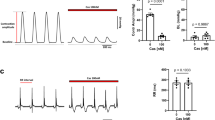Summary
The aim of this work was to use the binding assay of tritiated-dihydropyridine and radioiodinated Tx1, isolated from the Phoneutria nigriventer venom, in order to show the presence of Cav1 calcium channels on pituitary tumour cell (GH3). We showed that GH3 cells have specific sites for 125I-Tx1, which are sensitive to nifedipine (~20%). Reverse competition assay with 3H-PN200-110 (40% inhibition) and electrophysiological data (50% inhibition) suggest that Cav1 calcium channels are target sites for this toxin. To summarize, Tx1 binds to specific sites on GH3 cells and this interaction results in Cav1 calcium channel blockade. 3H-PN200-110 and 125I-Tx1 binding assays proved to be useful tools to show the presence of calcium channels on GH3 cells.
Similar content being viewed by others
Author information
Authors and Affiliations
Rights and permissions
About this article
Cite this article
Gouv?a dos Santos, R., Soares, M., Cruz, J. et al. Tx1, from Phoneutria nigriventer spidervenom, interacts with dihydropyridine sensitive-calcium channels in GH3 cells. J Radioanal Nucl Chem 269, 585–589 (2006). https://doi.org/10.1007/s10967-006-0269-4
Issue Date:
DOI: https://doi.org/10.1007/s10967-006-0269-4




